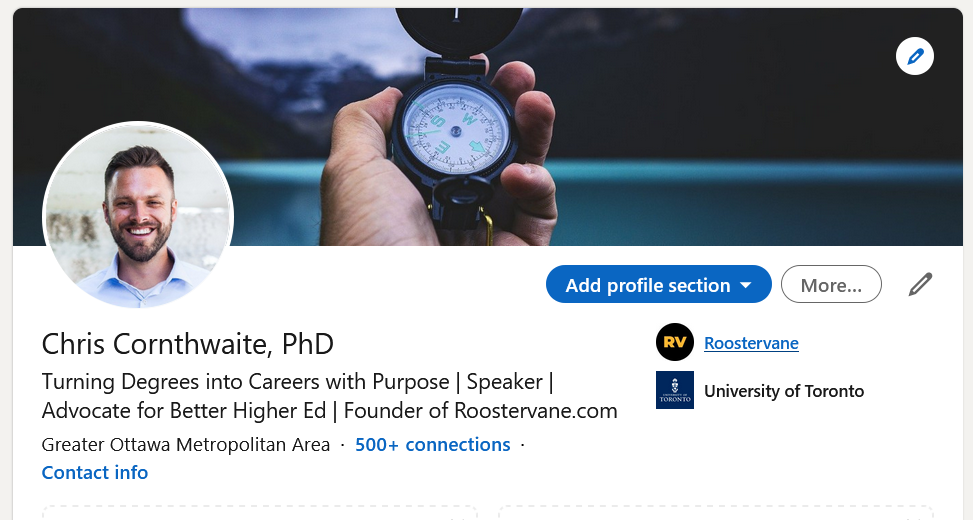

LinkedIn Tips for PhDs: 4 Hacks to Get You Hired
LinkedIn is a professional social network where users can post their resumes and accomplishments to find work. Networking to find career opportunities is vital for academic professionals, especially PhD graduates and postdoctoral researchers. LinkedIn also allows users to connect their social profiles and showcase their raw skills and personalities. With this combination, users can find a job that fits their various needs. It is easy to create an eye-catching and interesting profile by using the right strategies!
Making Connections
When starting out in the professional world, most PhD graduates do not have many professional contacts. This is quite normal, early in a graduate’s career. However, it can seem overwhelming if someone doesn’t know how to network. The best way for a new graduate to build a network on LinkedIn is to connect with people they know. Academic contacts from school are the obvious choice, but connecting with family can also be helpful. Millions of people use LinkedIn, and people may be connected in unexpected ways.
Finding a job on LinkedIn sometimes depends on small things. It may not be obvious who could help a PhD graduate the most. New graduates should reach out as much as they can when trying to make connections. LinkedIn has many groups where people with similar education and interests can find a common ground for a good connection. Some of these groups, like alumni groups, may contain even more contacts than a student already knows. These contacts may have new leads of their own, and those new people may take notice.
In today’s modern and interconnected world, CVs alone are not enough to get a job, no matter how impressive they are. Sending a resume to a job posting does not help many graduates, because there are so many people who do the same thing. Therefore, it is difficult for one resume to get noticed in a large group. Personal connections make a graduate seem more interesting, and encourage others to take another look.
Building a Profile
A LinkedIn profile has a different style than a CV. Many graduates upload their CVs to LinkedIn and assume that it will function the same way. However, this is a common mistake. Graduates should make sure their profile is 100% complete as a complete profile contains things not found on a CV. An effective LinkedIn profile contains a profile picture and a catchy summary. It often includes pictures as well, to emphasize a graduate’s experience.
Because LinkedIn is not like a CV, graduates can add many different things to their profiles. Links to accomplishments, portfolios, or social media are often useful. This can add to a reader’s positive perception of the graduate by proving that the person is hard-working, or has contributed to something significant. These unique pieces of a profile are usually free of buzzwords and jargon to help the reader get to know the graduate.
LinkedIn profiles can do more than highlight professional accomplishments. They can showcase personal successes, and these can be just as important. Sometimes, highlighting unique skills in a graduate’s personal life can grab a reader’s attention. Things that may not seem directly applicable to the professional world might be an asset in some careers. Showing one’s unique personality through personal accomplishments can help a graduate stand out.
Be Social and Proactive
When making connections on LinkedIn, it is important that a graduate be social and proactive . Writing personalized requests for connections on the platform can spark someone’s interest, and could lead to more connections. Recommendations are another important part of being on LinkedIn. It is helpful to gain recommendations for skills from connections, but giving recommendations to others can open the door for new connections as well.
To get connections from others, a graduate must be ready to reach out when necessary. LinkedIn is not like other casual forms of social media. It is a network of professionals, so accepting connections from people a graduate does not know involves very little risk. In fact, connecting with new people gives the graduate a much better chance of being noticed and finding a job. It is still important to ensure that new connections are trustworthy and this is easy to do by looking at their profiles and connections.
Because LinkedIn is a social network, users have the ability to share whatever they wish. However, graduates should remember that LinkedIn is a professional and not a casual environment. This means that anything the user shares could reflect on them professionally. Joke posts, politics, or other controversial topics are not appropriate for a LinkedIn profile. Being proactive means telling the world about oneself, but this should be done in a professional and neutral way.
Keep It Simple to Stand Out
Knowing all the capabilities of LinkedIn, graduates may be tempted to create a long profile, containing minute details of their work. However, most readers do not go through long profiles and it is best to keep them simple . No reader wants to sit through a long, specialized summary when carefully chosen words and a few pictures could do the same job. This can apply to any area of a graduate’s profile. Too much detail can bore readers, instead of enticing them.
The best way to avoid making a profile too complicated is to give information in small chunks. Small pieces of information are easy to read and understand. Carefully wording these small pieces can tie together a graduate’s profile while giving the reader essential information. A LinkedIn profile is not just a list of accomplishments, it is also a marketing tool.
A LinkedIn profile should not only give the reader enough information to generate curiosity about the graduate, but also leave them wanting to know more. If readers want to know more, they will contact the graduate. The new contact could be a passive connection, but they will still expand the graduate’s network. If the new contact decides to contact the graduate for a job, the LinkedIn profile is then at its peak effectiveness, doing exactly what it was meant to do.
For more details, the following links may be helpful: Part 1 , Part 2 , and Part 3 .
Have you created your own LinkedIn profile? What steps did you follow to create your profile? Share your thoughts with us in the comments section below!
Its easier said than done. My experience says 8/10 people don’t respond to a personal message. I have tried sending a message with a nice introduction about myself and then asking for a referral. Though I have read somewhere that it’s not a good idea to ask for a referral/job in the first message. But I think LinkedIn is a platform for professional and being direct into context is no harm, as long as someone is not repeatedly messaging. I feel bad to see that a person is very active in LinkedIn and not responding to the message written in a very modest and formal way. Jobseekers don’t always expect a positive reply from the people but any kind of reply would surely make them happy.
Rate this article Cancel Reply
Your email address will not be published.

Enago Academy's Most Popular Articles

- Career Corner
- PhDs & Postdocs
How Can You Make the Most Out of Virtual Scientific Conferences and Seminars: 6 Important Reasons for Researchers
This article is also available in: Turkish, Russian, Portuguese, and Spanish The unprecedented COVID-19 pandemic has been a trigger…

H-index — Is it Enough to Score Scientific Excellence?
Publishing your work is great for your career and future funding opportunities. It will increase…
How to Successfully Boost Your H-Index
How successful are you as a researcher? How good are your publications? What is the…

- Free Resources
Increase Your Visibility Through Digital Networking
Digitalization has changed the landscape of scientific research. Today, researchers can unravel several possibilities just…
- Promoting Research
- Using Online Media
Can Twitter Raise Your Research Profile?
In the past decade, the usage of the term “social media” seems to have increased…

Sign-up to read more
Subscribe for free to get unrestricted access to all our resources on research writing and academic publishing including:
- 2000+ blog articles
- 50+ Webinars
- 10+ Expert podcasts
- 50+ Infographics
- 10+ Checklists
- Research Guides
We hate spam too. We promise to protect your privacy and never spam you.
I am looking for Editing/ Proofreading services for my manuscript Tentative date of next journal submission:

What should universities' stance be on AI tools in research and academic writing?

- 11 . 12 . 20
Should I Put PhD After My Name on LinkedIn? Yes! Here’s Why.
- Posted by: Chris
Updated December 21, 2022
If you’re a PhD who is getting active on LinkedIn, or perhaps creating a profile for the first time, you might be wondering whether you should put PhD after your name.
In this short post, I argue yes and give my reasons. Don’t forget to read our guide to LinkedIn for PhDs here. You’re welcome to connect with me there too- Find me here!
This post may contain links to affiliate products, which–if you choose to purchase–pay us a commission at no extra cost to you. This helps to support our work. We only promote products we’ve used and love.
You can read my story about leaving academia in Doctoring: Building a Life With a PhD–Available on Amazon.
Should I put PhD after my name on LinkedIn?
Yes. There’s no harm in including PhD after your name on LinkedIn, and it may help. As your career progresses, you can decide whether or not to keep it as your skill-set gets more defined and you build a reputation for other things.

Why you might leave PhD off of your LinkedIn profile
The reasons often cited for leaving your PhD off of your LinkedIn profile are as follows:
1. Overqualification
How many PhDs believe that they are overqualified, especially since they’re often told this by managers?
I am hesitant to accept this. Managers might be concerned about two things: someone whose overqualified might expect higher compensation or might get bored and leave fast. Either of these might be reasons why they say you’re overqualified, but you can have that conversation in an interview–if you get there.
However, on LinkedIn, you want to attract the highest denominator of people who would be interested in your talent–as in, people who could actually envision a use for your PhD. Yes, they exist. You want to get the most AMAZING people to notice you, not the manager with no imagination who wants to use you for grunt work.
Did you know? When managers don’t want to hire PhDs, for any number of reasons, overqualification becomes an easy excuse for them to say no. If you suck at interviewing or don’t have the experience, they can let you down gently by saying, “We would have loved to hire you, but you’re overqualified.” It’s difficult to know if they’re actually telling the truth or if you are ACTUALLY overqualified.
2. Changing Industries
Some PhDs, like me, end up working in a different field than what their PhD was in. They’re worried that including a PhD on their LinkedIn profile is misleading since they haven’t actually obtained the qualification in their new industry.
If that’s the case for you, keep it on. Everybody’s career trajectory is different, but if PhD is a PhD. If people care enough about the details of your history, they can go figure out that you have changed fields. And if your PhD was in English literature, they won’t hire you for a job that requires a PhD in neurobiology–simple as that.
Why I think you should include it…
1. phds are leaders.
If you have a PhD, you are a leader. In the long term, develop a big-ass vision for your life and work that lets you operate at the very edge of all of your potential.
Today you might need a crap job to pay the bills. I’ve been there.
Tomorrow, once the bills are paid with your telemarketing gig (true story from a PhD I know), step out and grow a vision worthy of you.
I don’t care what somebody told you about you being overqualified, the hardest thing about being a PhD in the labor market is growing your leadership ability to match the letters after the name.
There are a lot of things you can do to influence your brand. You can create a LinkedIn account for example that screams leader instead of a dispensable employee.
But either way, those letters after your name are a sign of your greatness. I wouldn’t get rid of them. I would grow the rest of your brand until you look like a leader to everybody who looks at you.
2. People respect it
It might be hard to believe, but there are a lot of people out there who respect your PhD. I think some PhDs get mixed messages about this because they talk to family members or others who don’t understand our world.
The thing is, you need to understand that not all work outside of Academia is created equal. Not all of it will respect your PhD.
So your uncle who is in management at a paper mill or your cousin who works in a municipal government office are not going to get it. Why would they? They are not in the right type of workplaces.
Some PhDs do end up working in these kinds of spaces. And sometimes aren’t appreciated.
However, if you can get around the knowledge economy, your PhD is going to be respected.
So leaving it off of your LinkedIn because of what certain people might think is actually pandering to the wrong people anyways. You want knowledge economy people to notice you, and it’s totally fine if some of the others don’t.
FURTHERMORE! I’ve heard from women and racialized folks that including the “Dr.” or “PhD” can, in some cases, help them get the respect they deserve.
Working on some new skills? Try LinkedIn Learning here!
3. You might remove it with time
I’ve noticed that, with time, some of my contacts who are PhDs have removed the letters from after their names. In most of these cases, they’re not job searching. They are established and known for things other than their PhD. They’re running companies, they have high-quality product management skills, etc.
If you are just starting out, it makes total sense to keep PhD on your LinkedIn. And make sure your LinkedIn looks great, I have a guide for how to do that here.

Why You NEED to Trust Yourself
It was one of those stupid “get rich quick” ads online. You know the type. The “I made $5 million last year selling my online

What is a PhD? All you need to know for 2024
When I started my PhD, I went in without a lot of thought. I had finished a master’s. It seemed like the logical next step,

15 Skills to Put on a Resume in 2023 (Employers LOVE These!)
When I was starting my career, I used to think about degrees a lot. I’d list them on my resume, all proud and shiny. But
SHARE THIS:
EMAIL UPDATES
Weekly articles, tips, and career advice
Roostervane exists to help you launch a career, find your purpose, and grow your influence
- Write for Us
Terms of Use | Privacy | Affiliate Disclaimer
©2022 All rights reserved
Press ESC to close
Or check our popular categories....

How to Add PhD to Name in LinkedIn?
Table of Contents
Have you finished your studies and earned your Ph.D. ? So do you want to know how to add a Ph.D. to your name on LinkedIn ? Should you add a Ph.D. to your name at all? Read the rest of this text to get the answer.
Higher education has been our modern world’s normal for some decades. There are not as many people who never went to college or universities as there were about 50 years ago. Many people have bachelor’s, master’s , or other degrees around you, and many earn their degrees every semester in different fields.
Maybe that’s why it’s been harder to find a decent job with a high school diploma . Of course, there is nothing wrong with choosing not to go to college or anything; all we are saying is that there are a lot of more educated people on the market right now.
At the same time, there are people with Ph.D. degrees. I mean PhDs are not as many people with other degrees but still a lot more than they were before.
But why do people choose to include Ph.D. in their LinkedIn name? We don’t see other people do such a thing, do we? I have a master’s degree and never even considered including it in my name.
Well, because being a Ph.D. is an honor. High education is challenging, but a Ph.D. degree is quite an achievement.
People not only share that they have a Ph.D. in their posts, but they also add it to their education and to their names.
How to add a Ph.D. to your name on LinkedIn? There are some ways to do it.
You can add it to the education section, and thankfully LinkedIn allows you to add any suffixes to your name.
- Log into your account
- Choose “View Profile” from the “Me” dropdown menu in your account’s top right corner.
- Click the pencil icon under your cover photo .
- Add Ph.D. to your last name box
- Click Save.
Adding Ph.D. to your LinkedIn name pros and cons
That is the way you have to add a Ph.D. suffix to your name, but the experts still can’t agree upon whether you should add it to your LinkedIn name or not, and each group has its own reasons to do so or not to do it.
Future leaders
A lot of PhDs have experienced it. They had to do crap, low-paid jobs just to pay the bills and their student loans. But after a while, they get employed for a decent leadership position. Industries know that PhDs can make perfect leaders.
The respect
Now, there is no argument on this one; it is like an ancient gene in humans. Most of us respect people with PhDs unintentionally, just like the way people used to respect Aristotle, Confucius, Democritus, and many others. Not like they had a Ph.D. or something; it’s about the knowledge and thoughts.
Over-qualification
Well, it is a wholly known saying, and you might have already heard it in some interviews you had: “You are overqualified for the available post for you’re a Ph.D.”
So you have two ways. You can either choose to remove the suffix from your name to attract more recruiters (in every field with every job they are looking for candidates for) or just leave it there and wait for the one who is looking for someone with a Ph.D. to lead their company .
It is perfect that you’ve earned a Ph.D. and you can find some very decent jobs now, whether in industries or the education system. You just needed to know how to add a Ph.D. to your name on LinkedIn, and now you do. So, go on and enjoy your knowledge.
Related Questions & Answers
How do i write a linkedin headline for a phd student.
When crafting a LinkedIn headline as a PhD student, it’s essential to highlight your expertise, academic pursuits, and future aspirations. Here’s a straightforward guide on how to write a LinkedIn headline for a PhD student:
- Emphasize your specialization: Begin by mentioning your specific field of study or research specialization in your headline. For example, you can include keywords like “PhD Candidate in [Field of Study]” or “Researcher in [Specialization].” This immediately communicates your academic focus and expertise to potential connections and employers.
- Showcase your accomplishments and goals: Highlight any notable achievements, such as published research papers, conference presentations, or awards. Additionally, include a phrase that conveys your future aspirations or career goals. For instance, you could mention “Seeking opportunities in [Industry/Field] to apply research expertise” or “Passionate about driving innovation and solving complex problems in [Area of Interest].”
By combining your academic focus with your professional aspirations, you create a compelling LinkedIn headline that showcases your expertise as a PhD student while signaling your ambition for future career opportunities.
Should I Put an MBA After My Name on LinkedIn?
When creating your LinkedIn profile, it’s common to question whether including credentials such as an MBA after your last name is appropriate. Adding “MBA” to your profile name can highlight your qualifications and make your profile stand out to people browsing LinkedIn. It serves as a succinct signal of your professional and academic achievements.
To include it, edit the name field in your profile to append “MBA” after your last name, ensuring it aligns with LinkedIn’s guidelines for profile names. This addition can enhance your resume on LinkedIn, making your advanced degree visible at a glance, which can be particularly beneficial in fields where such a credential is highly valued.
How Do I Add PMP After My Name on LinkedIn?
To add “PMP” after your name on LinkedIn, indicating you have earned the Project Management Professional credential, you should navigate to the profile editing section and locate the name field.
Here, you can append “PMP” after your last name, effectively using your profile name to showcase this significant professional achievement. Including such credentials in your LinkedIn name makes it easier for people to recognize your expertise and qualifications directly from your profile overview. It’s a strategic way to communicate your specialized knowledge and professional standing within the project management community.
How to Add Credentials to LinkedIn Name?
Adding credentials to your LinkedIn name involves a simple but strategic update to your profile. To do so, access the editing mode of your LinkedIn profile and locate the name field. In this field, you can append relevant credentials, such as PhD, CPA, or any other professional or academic distinction directly after your last name.
This practice ensures that your highest qualifications are immediately visible to anyone viewing your LinkedIn profile, succinctly highlighting your professional and academic credentials. Remember to include only the most relevant credentials to maintain clarity and professionalism in your profile presentation.
How to Add PMP to Your Name on LinkedIn?
To add “PMP” to your name on LinkedIn, indicating your certification in Project Management, you should click on the profile editing option and modify the name field to include a “PMP” suffix after your last name.
This adjustment showcases your professional qualification prominently, allowing peers, recruiters, and potential connections to identify your expertise in project management quickly. It’s a powerful way to leverage LinkedIn for professional branding, making your specialized certificate visible and accessible at the top of your profile.
How to Add Degree to LinkedIn Name?
Incorporating your degree into your LinkedIn name is straightforward. You can edit your profile and append the degree, such as “PhD,” “MBA,” or any other academic credential, next to your last name in the PhD name field.
This action places your academic achievements front and center on your LinkedIn profile, offering a quick overview of your educational background to visitors. It’s an effective method to highlight your academic credentials, making it easier for connections and recruiters to assess your qualifications at a glance.
How to Add MBA to LinkedIn Name?
Adding an MBA to your LinkedIn name is a strategic move to showcase your business qualifications prominently. To include it, edit your LinkedIn profile, appending “MBA” after your surname in the name field.
This addition immediately informs viewers of your advanced business studies, potentially increasing your appeal to prospective employers or clients browsing PhD LinkedIn. It’s a concise way to signal your professional status and academic achievement within the business community.
Additional Name in LinkedIn Example
For an additional name example on LinkedIn, professionals might include credentials like “John Doe, CPA” or “Jane Smith, PhD” in their profile names. This practice involves editing the profile’s name field to append a credential or qualification, such as a CPA license or a PhD degree, making these qualifications immediately visible.
This strategy can enhance your LinkedIn presence by succinctly communicating your professional or academic status to viewers, potentially facilitating more relevant professional connections.
Should You Put Your Credentials After Your Name on LinkedIn?
Putting your credentials after your name on LinkedIn is a matter of personal and professional preference, but it is generally considered a good practice in many industries. This approach helps to quickly convey your qualifications and professional standing to viewers, making it particularly useful for individuals in fields where specific degrees, certifications, or professional designations are highly regarded.
Including credentials like PhD, CPA, or PMP in your profile name provides a clear, immediate indication of your expertise and qualifications. This can enhance your visibility and appeal to LinkedIn recruiters, connections, and peers.
How to Add CPA to LinkedIn Name?
To add “CPA” to your LinkedIn name, showcasing your certification as a Certified Public Accountant, you should access your profile’s editing feature and append “CPA” to your name in the name field. This inclusion prominently displays your professional certification, signaling to viewers your expertise in accounting and finance. It’s an effective way to utilize your LinkedIn profile for professional branding, ensuring that your credentials are immediately noticeable by employers, clients, and colleagues navigating through the platform.
How do you put a PhD on LinkedIn?
To add a Ph.D. to your LinkedIn profile, follow these steps:
- Log In to LinkedIn: Visit the LinkedIn website and log in to your account.
- Access Your Profile: Click on your profile picture or your name to access your LinkedIn profile.
- Edit Your Profile: On your profile page, you’ll see an “Add profile section” button. Click on it.
- Choose “Education”: From the dropdown menu, select “Education.”
- Enter Your Ph.D. Details: In the “Education” section, enter the details of your Ph.D. Include the university or institution where you earned your Ph.D., the degree title (e.g., Doctor of Philosophy), the field of study or major, the dates of your enrollment and graduation, and any relevant honors or awards.
- Optional: Provide a Description: You can include a brief description highlighting your research focus, dissertation topic, or academic achievements during your Ph.D. program.
- Save Changes: After entering the details, click the “Save” button to add your Ph.D. to your LinkedIn profile.
By adding your Ph.D. to your LinkedIn profile, you emphasize your academic accomplishments and expertise, making your profile more appealing to potential employers and professional connections in your field.
How do you add a degree next to your name on LinkedIn?
On LinkedIn, you can’t add a degree next to your name as you would in formal email signatures or academic publications. LinkedIn’s profile format doesn’t accommodate degree titles directly next to your name like a prefix or suffix. Instead, LinkedIn offers dedicated sections where you can list your degrees and qualifications, such as the “Education” section. You can provide details about your degrees there, including the degree title, field of study, university, and dates of enrollment and graduation. While you can’t display the degree directly next to your name on LinkedIn, listing it in the appropriate section still effectively showcases your educational qualifications to your professional network.
How do I add a PhD to my name?
On LinkedIn, you can’t directly add a degree like “Ph.D.” to your name in the same way you might use a prefix or suffix in formal contexts. LinkedIn follows a structured format where your name and credentials are separate. Instead, you should include your Ph.D. in the “Education” section of your LinkedIn profile. In this section, you can provide all the details of your Ph.D., including the degree title (Ph.D.), field of study, university, and graduation dates. This way, your LinkedIn profile effectively showcases your academic achievement without altering your name format, maintaining a professional and consistent appearance on the platform.
How do you mention a PhD degree?
When mentioning a Ph.D. degree in your professional communication or documents, it’s typically included after your name and separated by a comma. For example, if your name is John Smith and you have a Ph.D. in Psychology, you would write it as “John Smith, Ph.D.” This format signals your academic achievement and expertise. You can use this format in email signatures, on your LinkedIn profile, in academic publications, or wherever appropriate in a professional context to convey your qualifications accurately.
CUFinder Academic Hub, Ultimately Free!
These comprehensive PDFs are your key to mastering the art of professional networking, personal branding, and strategic content creation on LinkedIn.
Click here to Download these ebooks for free!

Categorized in:
Share Article:
Leave a Reply Cancel reply
Save my name, email, and website in this browser for the next time I comment.
Related Articles
Linkedin summary template for career changers, linkedin tips for resume, linkedin tips and tricks for students, essential linkedin tips to get a job, other stories, how to add pluralsight courses to linkedin, how to add patents to linkedin.
PhD Students
Paolo adajar, thesis writer.
Research Fields
Labor Economics Development Economics Market Design Behavioral Economics

Salome Aguilar Llanes
Labor Economics Public Economics

Isabel Almazan
Labor Economics Public Economics Industrial Organization

Isadora Angelini Frankenthal
Second year.
Development Economics Political Economy

Karl M. Aspelund
Environmental Economics Industrial Organization Public Economics

Lucas Barros
Economic Theory

Jules Baudet
Econometrics Economic Theory

Louis Becker
International Economics Industrial Organization Development Economics

Keelan Beirne
Macroeconomics Economic Theory

Aaron Berman
Development Economics International Economics Environmental Economics Health Economics

Laurel Britt
Financial Economics Macroeconomics

Hazel Browne
Development Economics Economic Theory
Rebecca Cai
Development Economics Behavioral Economics Labor Economics

Theodore Caputi
Health Economics Political Economy Public Economics

Tomas Caravello
Macroeconomics Econometrics Financial Economics

Anne Carlstein

Alex Carrasco Martinez
Macroeconomics Economic Theory Public Economics

William Chen
Macroeconomics Financial Economics Labor Economics

Caroline Chin

Valerie Chuang
Public Economics Environmental Economics

Viola Corradini
Job market candidate.
Labor Economics

Roberto Corrao
Economic Theory Organizational Economics

Economic Theory Behavioral Economics

Tuval Danenberg
Economic Theory Political Economy Behavioral Economics

Marc de la Barrera i Bardalet
Macroeconomics Labor Economics Financial Economics
Clara Isabel Di Tella
Financial Economics International Economics Macroeconomics
Rebekah Dix
Industrial Organization

Jamie Emery
Public Economics Labor Economics

Brandon Enriquez

Juan Escolar
Macroeconomics Development Economics Labor Economics

Camille Falezan
Behavioral Economics Development Economics Public Economics

Juan Gambetta Rossi
Development Economics Macroeconomics

George Garcia
Development Economics Environmental Economics Political Economy


Tishara Garg
International Economics

Public Economics Health Economics Economic Theory

Sarah Gertler
International Economics Macroeconomics Industrial Organization

Julia Gilman
Labor Economics Behavioral Economics

Development Economics Labor Economics

Ahmet Gulek
Labor Economics Public Economics Development Economics Econometrics

Basil Halperin
Macroeconomics Financial Economics Economic Theory

Sarah Hamerling
Economic Theory Financial Economics Macroeconomics

Raymond Han
Adam Harris

Nathaniel Hickok
Industrial Organization Environmental Economics Behavioral Economics

Deivy Houeix
Development Economics Organizational Economics Public Economics Labor Economics

Vicente Jiménez G.
Macroeconomics Economic Theory Financial Economics

Mohit Karnani
Development Economics Econometrics Industrial Organization

Shinnosuke Kikuchi
Macroeconomics International Economics Political Economy

International Economics Macroeconomics

Sylvia Klosin
Econometrics Public Economics
Geoffrey Kocks
Labor Economics Health Economics

Economic Theory Financial Economics Industrial Organization

Andrew Komo
Market Design Labor Economics Industrial Organization

Fredric Kong
Development Economics International Economics Labor Economics Macroeconomics
Haruki Kono

Kelsey Larson
Environmental Economics Development Economics Economic Theory

Nathan Lazarus
Labor Economics Development Economics Public Economics

Todd Lensman
Macroeconomics Industrial Organization Political Economy

Industrial Organization Economic Theory Financial Economics

Health Economics Labor Economics Public Economics

Public Economics Industrial Organization Economic Theory

Jeremy Majerovitz
Macroeconomics Development Economics Econometrics

Alex Martin
Economic Theory Financial Economics
Pedro Martinez-Bruera
Econometrics Macroeconomics Public Economics

Jackson Mejia
Macroeconomics Public Economics

Chelsea Mitchell
Industrial Organization Labor Economics

Carlos Molina
Political Economy Development Economics Behavioral Economics

Econometrics
Valeria Morales Vasquez
Behavioral Economics Financial Economics Macroeconomics

Kelsey Moran
Health Economics Public Economics Labor Economics

Bruno Moscarini
Macroeconomics Public Economics Labor Economics

Florian Mudekereza
Economic Theory Econometrics Behavioral Economics

Aroon Narayanan
Industrial Organization Organizational Economics Economic Theory

Vishan Nigam
Development Economics Environmental Economics Labor Economics
Shakked Noy
Behavioral Economics Labor Economics Political Economy

Daniel O'Connor
International Economics Urban Economics Macroeconomics
Industrial Organization Public Economics

Victor Orestes
Econometrics Macroeconomics

Environmental Economics Behavioral Economics

Lia Petrose

Jett Pettus

Víctor Quintas-Martínez
Econometrics Labor Economics Industrial Organization

Kramer Quist
Organizational Economics

Charlie Rafkin
Public Economics Behavioral Economics

Kailash Rajah

Eduardo Rivera Ortiz
Development Economics Public Economics Political Economy

Vincent Rollet
Political Economy Urban Economics Labor Economics

Hannah Ruebeck
Behavioral Economics Labor Economics

Environmental Economics Public Economics Industrial Organization

Sivakorn Sanguanmoo

Pedro Sant'Anna
Behavioral Economics Political Economy Development Economics

Eitan Sapiro-Gheiler
Political Economy Economic Theory Behavioral Economics

Ian Sapollnik

Reca Sarfati
Development Economics Economic Theory International Economics Macroeconomics

Yucheng Shang
Industrial Organization Economic Theory

Kazuatsu Shimizu
Macroeconomics

Ryo Shirakawa

Advik Shreekumar
Behavioral Economics Political Economy Econometrics

Charlotte Siegmann
Economic Theory Industrial Organization Political Economy Development Economics

Adam Solomon
Public Economics Behavioral Economics Economic Theory

Evan Soltas
Public Economics Urban Economics Labor Economics

Vanessa Sticher
Behavioral Economics Political Economy

Nagisa Tadjfar

Ishaana Talesara
Labor Economics Development Economics

Aidan Toner-Rodgers
Labor Economics Macroeconomics Econometrics

Bobby Upton

Economic Theory Macroeconomics Financial Economics

Rafael Veiel
Economic Theory Macroeconomics

Suhas Vijaykumar

Vod Vilfort

Kartik Vira
Behavioral Economics Labor Economics Political Economy Public Economics
Jaume Vives-i-Bastida
Econometrics Industrial Organization

Cristine von Dessauer
Development Economics Industrial Organization Political Economy

Labor Economics Public Economics Development Economics

Labor Economics Political Economy Behavioral Economics

Laura Weiwu
Labor Economics International Economics Urban Economics Economic History

Parker Whitfill
Economic History Political Economy Development Economics

Arthur Wickard
Macroeconomics Labor Economics

Edward Wiles
Development Economics Behavioral Economics

Megan Yamoah
Development Economics International Economics Labor Economics

Labor Economics Financial Economics Development Economics

Whitney Zhang
Labor Economics Public Economics Behavioral Economics

Henry Zhang
Financial Economics International Economics Environmental Economics


IMAGES
COMMENTS
South San Francisco, CA $47 - $52. Actively Hiring. 2 days ago. Today's top 75,000+ Phd jobs in United States. Leverage your professional network, and get hired. New Phd jobs added daily.
This article provides 7 strategies for PhDs to ditch the academic mindset and create a LinkedIn profile that will get them hired in industry. 3 Ways To Ruin Your Job Search With A Poor LinkedIn Profile. Your job search will have many components. Networking, writing a resume, updating your LinkedIn profile, interviewing… each of these is ...
Steps. Step 1: Use a professional picture of you smiling. Step 2: Pick a "Headline" that says what you do or what you want to do. Step 3: Write an easy-to-read career story in the "About" section. Step 4: Fill in the "Experience" section with your work history and great examples. Step 5: Add some projects and links.
LinkedIn Scholars is a program that enables academics to contribute directly to LinkedIn's vision of creating economic opportunity for every member of the global workforce. Scholars will gain practical experience combining industry knowledge with academic expertise to solve complex business problems spanning all areas of engineering, with an ...
LinkedIn is a professional social network where users can post their resumes and accomplishments to find work. Networking to find career opportunities is vital for academic professionals, especially PhD graduates and postdoctoral researchers. LinkedIn also allows users to connect their social profiles and showcase their raw skills and ...
Learn the latest LinkedIn tips & strategies to get PhDs hired into top industry careers. Create a professional brand to showcase your LinkedIn profile. Learn how to increase your LinkedIn visibility to employers. Focus on keywords that will attract recruiters to you from LinkedIn Recruiter. Learn how to create a conversational hook that will ...
Today, we will discuss 11 sections of a LinkedIn profile, why they are important, and what information you should include in each of them. 1. Visual center. The visual center is the part of your profile that shows on the screen without the person having to scroll down. It includes the banner photo, profile picture, and headline and is the most ...
Posted by: Chris. One morning in December, I put the call out on Twitter that anyone with an advanced degree looking to build a career should join the new Roostervane group on LinkedIn. Plus, I promised to do a LinkedIn review of anyone who joined that day. The requests started rolling in quickly. And by the end of the day, I'd reviewed 53 ...
However, on LinkedIn, you want to attract the highest denominator of people who would be interested in your talent-as in, people who could actually envision a use for your PhD. Yes, they exist. You want to get the most AMAZING people to notice you, not the manager with no imagination who wants to use you for grunt work.
Get early seat to advanced LinkedIn webinar training for PhDs: https://cheekyscientist.com/phd-linkedin-strategy/Watch this video to learn 7 key sections on ...
To add a PhD to your name on LinkedIn, go to your profile and click on the "Edit" button. In the "Name" field, add "PhD" after your last name. Then, click "Save" to update your profile. At the same time, there are people with Ph.D. degrees. I mean PhDs are not as many people with other degrees but still a lot more than they were before.
Dr Maria Alejandra Pinero de Plaza, PhD, is a scientist facilitating healthy living and better public health services. Dr Pinero de Plaza strengthens researchers, clinicians, industry, and consumers' abilities to design, measure, and accomplish different health and social impacts. Her experience in mix-methods, experimental design, and evaluation helps her identify and demonstrate how ...
Research Fields. Development Economics International Economics Environmental Economics Health Economics
I am Founder and Principal of Viswali Consulting and the author of "The Deliberate Doctorate: A Values Focused Journey to Your PhD" (UBC Press, On Campus, August 15, 2023). As a human-centred planner, I have 20+ years of experience in the not-for-profit and government sectors, and in academia. I focus my skills and emotional intelligence to develop collaborative approaches to systems change ...
Here are 7 hacks to increase the visibility of your LinkedIn profile and get hired…. 1. Increase the 'dwell time' for your profile. Dwell time is a phrase that's used in the online search industry quite a bit. Google cares a lot about dwell time. LinkedIn cares a lot about dwell time.
Ricky is such a pleasure to work with. He is so open minded and actively embraces the Multiplier ingredients such as upgrading his identity and leadership with enthusiasm and dedication and as a result he sees tremendous results. He is a natural leader with a wonderful combination of humility, conviction and boldness.
Director of Aviation & Deputy Director General of Tourism - Bahamas Ministry of Tourism, Investments & Aviation, Certified Behavioral Analyst, Global Leadership & Organizational Mgmt. Strategist, Coach, Trainer, Speaker · Dr. R. Kenneth Romer has held key private and public sector executive roles throughout The Bahamas, United Kingdom, Europe, USA and The Caribbean. He is widely ...
Change starts with awareness and that awareness often begins with assessment. As a…. · Experience: Stewart Leadership · Education: University of Kansas · Location: Richland, Washington ...
PHD | 235,457 followers on LinkedIn. Intelligence.Connected. | Welcome to PHD. Powered by our next-generation network, PHD's advanced thinking - Intelligence. Connected. - combines data, technology, and human expertise collaboratively to achieve greatness.